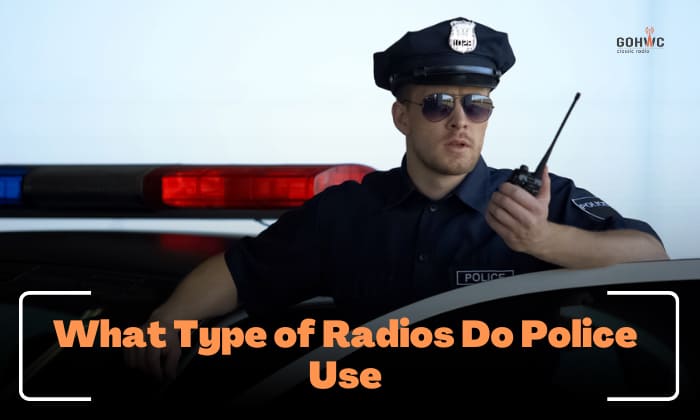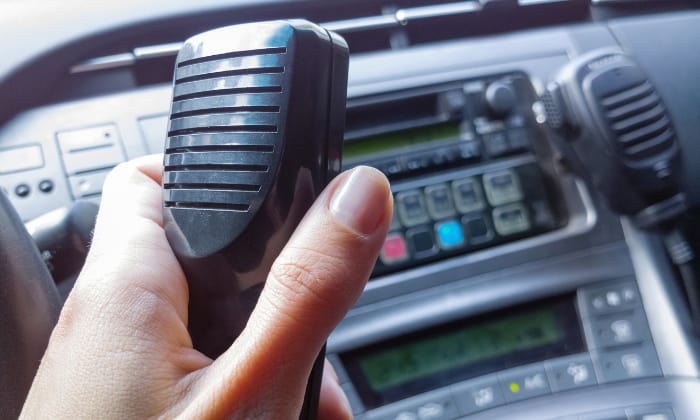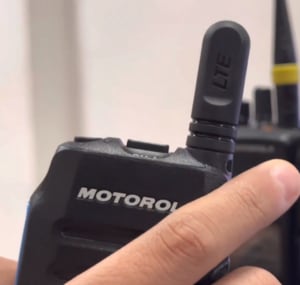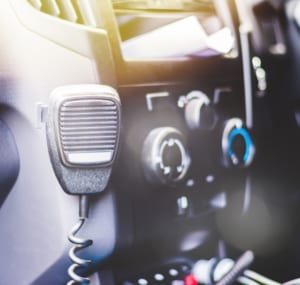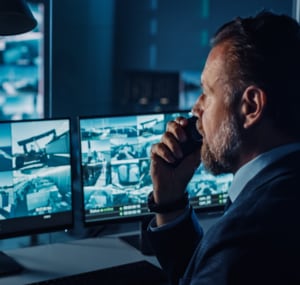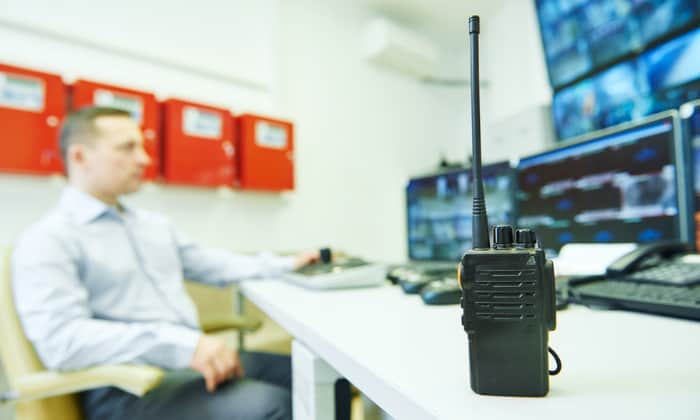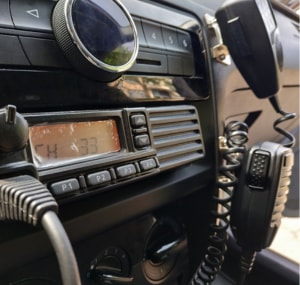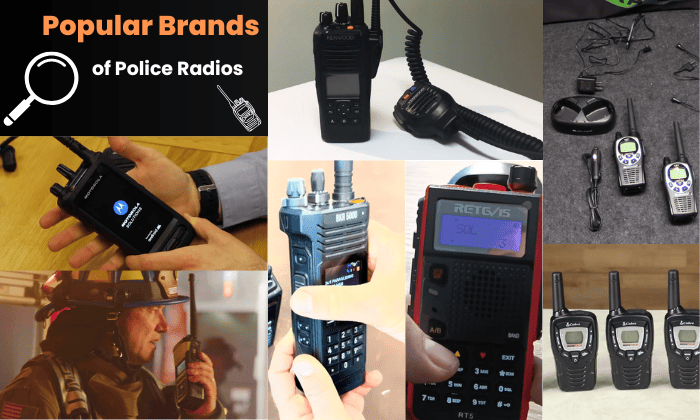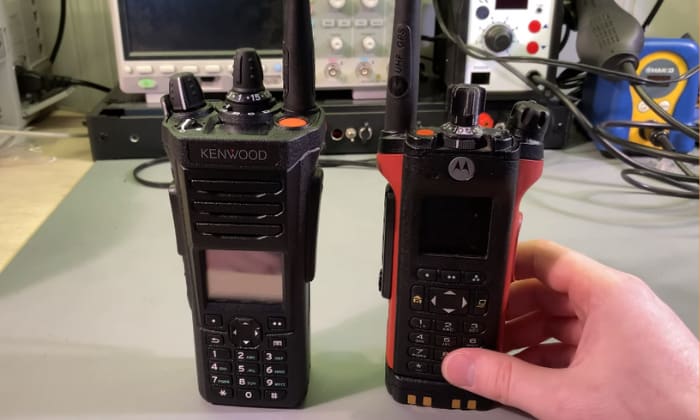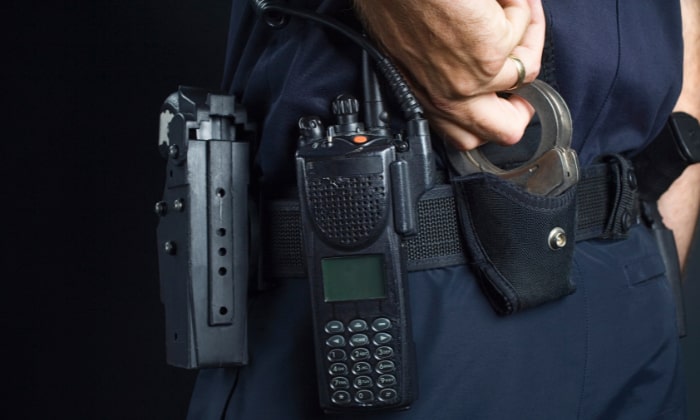When you witness an emergency and ask, “What type of radios do police use?” don’t be surprised to learn they use the usual two-way radios but with extra features. These analog/digital radios can be mobile or fixed in a base station.
Police car radios installed in dashboards are typical, while push-to-talk over cellular (PoC) radios are the ones you see in the standard gear of officers, with a microphone attached near their chest.
Contents
Types of Police Radios
Two-way radios are the pals of police officers, especially when they are on the road. These are the four types:
1. Walkie-talkies
Cops use walkie-talkies though they’re not like the regular ones. They are high-end and with a wide coverage made possible by the police districts’ expanded communication network.
For instance, in the US, law enforcers use Project 25 products, like the Motorola P25 APX two-way radio series.
In some places, the police force maintains a network of antennas and repeaters for a wide service area.
Walkie-talkies are helpful because they are easy to carry, user-friendly, and do not demand any complicated processes to maintain, much so that even used police radios can still be reliable.
They can work even when communication lines are absent. Walkie-talkies, even the analog ones, are dependable and can trump other kinds of radios.
The Federal Communications Commission (FCC) regulates radio frequency usage of two-way units. For Family Radio Service/General Mobile Radio Service (FRS/GMRS) or GMRS only walkie-talkies, a license is required before benefitting from their 462-467 megahertz (MHz) frequency.
2. PoC radios
The main difference between PoCs and ordinary two-way radios is the former’s use of subscriber identity module (SIM) cards because it works in a mobile network. To communicate using this radio, police officers just push a button to send a message. Hence, its name (push-to-talk over cellular).
Since the transmission in PoCs happens in a cellular network, they have wider coverage, making them effective police portable radios. Furthermore, while traditional radios depend on radio frequency, PoCs rely on internet protocol (IP) networks, making real-time communication possible.
Another key advantage of a PoC that makes it a reliable police officer radio is its global positioning system (GPS), text messaging, group call, and map features. Being modern devices, PoCs can also be integrated into other communication networks.
3. Citizens band radios
Do police use ham radios? The answer is yes, and they are as reliable as their handheld counterparts. Officers are not limited to using high-end Motorola police radios because they also employ traditional CBs installed in their mobile cars.
CBs are best used during patrols when police officers need to stay alert. CBs operate from 26.965 MHz to 27.405 MHz frequencies in at least 40 channels.
Though CBs are not as powerful as PoCs, they are as dependable. Hence, it’s not surprising that they don’t require a license and are a favorite of amateur radio enthusiasts.
4. Base station two-way radios
While roving police officers use portable radios, those in the headquarters and similar offices use base station units alongside handheld ones. Base station radios are part of the law enforcement communications system, serving as links to other police offices and field personnel.
Base stations connect with other base stations in different police units and with roving law enforcers.
Furthermore, if a police district permits it, civilian radio operators can connect to the base stations of police offices during emergencies. After all, base station radios have wide coverage, thanks to their effective use of antennas.
Programming Two-way Radios
If you’re a police officer working outdoors and, by any chance, encounters an issue with your two-way radio or a walkie-talkie channel, you should know how to program it.
Two-way radios are usually pre-programmed by suppliers, and in police setups, they are dealt with by the technical personnel.
- However, if you need to tinker with it while on the road, ensure first it’s not low on battery before turning it on.
- Afterward, set up the channel by pressing the ‘Menu’ button, then the ‘Up’ or ‘Down’ button until you see the word ‘Zone’ on the screen. A zone means a set of 16 channels.
- Press the ‘Menu’ button again to select the ‘Zone’ function, then press the ‘Up’ or ‘Down’ button to choose the zone you plan to use, which should be the previous one where your police 2-way radio operates.
- Once the channel is set up, speak over the radio by pressing the PTT button. When communication is achieved clean and clear, then the programming is successful.
Programming two-way radios is vital to ensure that police officers can promptly respond in times of crisis.
Security and Encryption of Police Radio Systems
Can walkie-talkies be traced and can walkie-talkies pick up police transmission?
Yes, if they are not encrypted. It is possible when civilians use scanners or mobile applications that allow them to have an ear on their local law enforcement’s radio communications.
However, some police forces are starting to encrypt their transmission, so only the receiver can access the communication. It is ideal when sensitive information is handled, like the location of reinforcement units, arresting teams, and the like during crises.
There are two types of encryption: tactical encryption is for protecting information related to law enforcement or operations, and full encryption is for limiting public access to the day-to-day grind of police radio operators.
So the next time you want to listen to police walkie-talkie codes, you can only do so when the communication is not encrypted.
Required accessories
If you’re a police officer who wants better two-way radio use, here are some accessories to consider, whether you’re working with a Motorola in a car police radio setup or a CB:
- Handset speaker
- Shoulder-mounted mic
- Earpieces (traditional, bone conduction, or listen-only)
Popular Brands, Models of Police Radios
What radios do police use? There are many models out there, but the following are among the most popular brands:
- Motorola Solutions
- L3Harris
- BK Technologies
- Kenwood
- Retevis
- Midland
- Cobra Electronics
Police Radio vs Commercial Radio
Since police radio equipment handles many transmissions and sensitive data, they are better than commercial two-way radios. Here are some key differences between the two:
| CAPABILITY | POLICE RADIO | COMMERCIAL RADIO |
| FEATURES | Has GPS Bluetooth, Long Term Evolution (LTE), wireless fidelity (Wi-Fi) functions, among others. | Has SOS emergency features. |
| CHANNEL | Operates in many channels and can go. For instance, Harris XL-200 radios have at least 1,000. | Operates from two to 16 channels; 30 at most. |
| RANGE | Has a wider range since it operates in 700 and 800 MHz ultra high frequency (UHF) bands. | FRS/GMRS radios can reach 30 to 40 miles. |
| SECURITY | Transmission can be partially or fully-encrypted. | No encryption. |
| LICENSING | Only FRS/GMRS and GMRS radios require licensing. | Only FRS/GMRS and GMRS radios require licensing. |
| ACCESSORIES | Needs additional requirements for better use. | Accessories are optional. |
| PRICE | Police radios are durable, high-end, and require additional accessories so they are pricier ($800 to $2,000). | Since commercial radios only have basic features and do not require accessories, they are cheaper (around $100). |
Project (P25) Police Radios
P25 is a standard set of digital two-way radios used by many police forces, thanks to its interoperability. Meaning, Motorola police transmitters can communicate with Kenwood radios. This way, police forces won’t have issues though they use different communication systems and networks.
Frequently Asked Questions
How long do the batteries of police radios typically last?
Depending on usage, the battery life of police radios can last up to 10 to 15 hours, enough for a day’s duty.
Can police radios communicate with other emergency services?
Yes, if they use P25 radios, which have interoperability features. If P25 is absent, police radios can still communicate with other emergency services through CBs, walkie-talkies, and base stations.
Conclusion
The next time someone asks, ”What type of radios do police use?” or “How do police radios work?” you are now armed with the knowledge to explain. Beyond that, you have the information about what makes police radios distinct from commercial ones.
Avoid scanning police transmissions because of the sensitive real-time information they handle. Sure, police radios are impressive, but only those not encrypted are free for the public’s ear.

Hello! I am Hart, the content writer and editor here at G0HWC. I used to be in the same local radio club with Howe, and he convinced me to join him in spreading my love for the radio with others. With a background in radio studies, I spend every day crafting accurate, easy to read content on various topics related to owning and using radios. I hope that my content can help you confidently venture in your radio journey!

